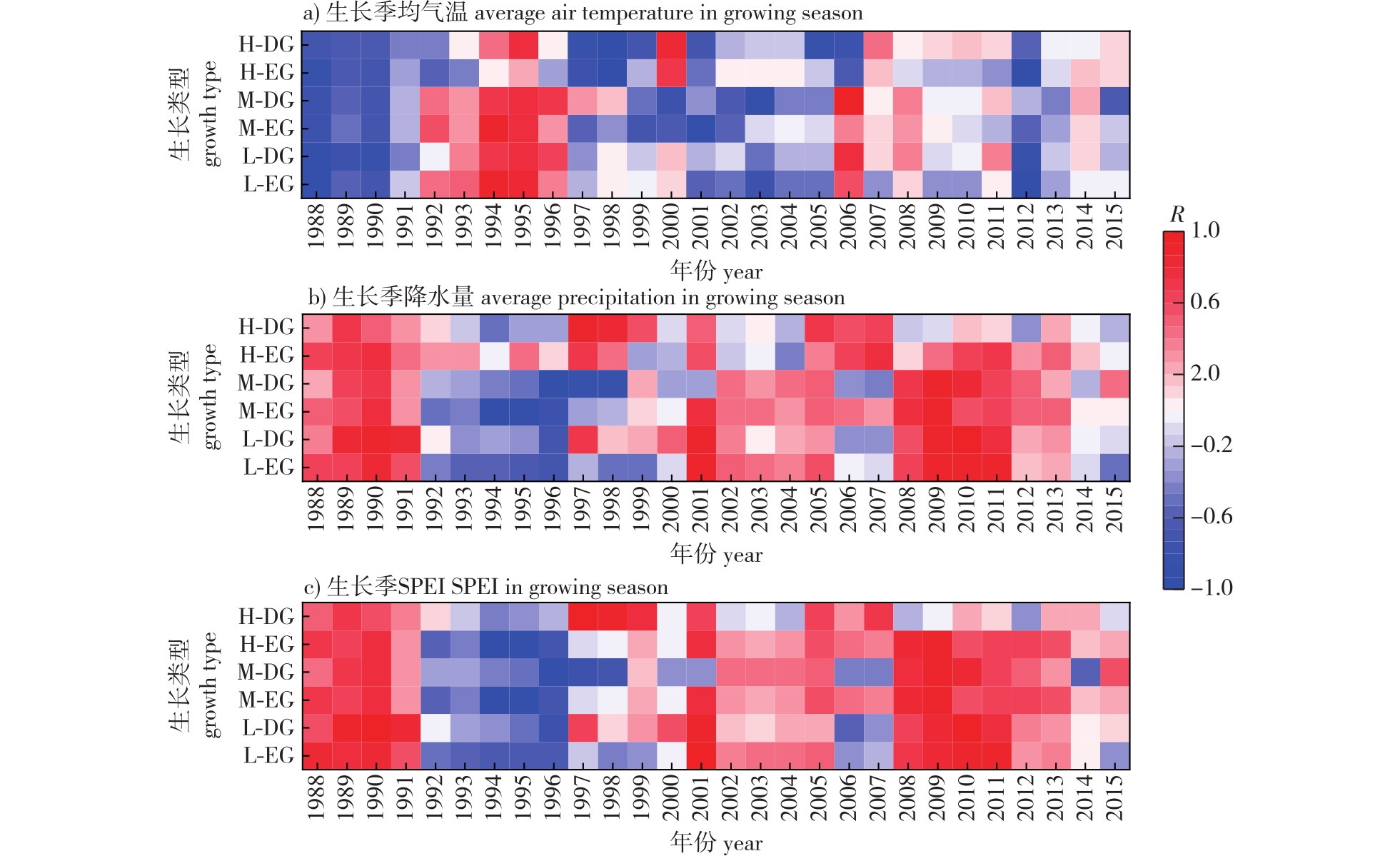 PDF(2250 KB)
PDF(2250 KB)


Effect of stand density on radial growth-climate relationship of Larix gmelinii
HAN Xinyu, GAO Lushuang, QIN Li, PANG Rongrong, LIU Mingqian, ZHU Yihong, TIAN Yiyu, ZHANG Jin
Journal of Nanjing Forestry University (Natural Sciences Edition) ›› 2024, Vol. 48 ›› Issue (2) : 182-190.
 PDF(2250 KB)
PDF(2250 KB)
 PDF(2250 KB)
PDF(2250 KB)
Effect of stand density on radial growth-climate relationship of Larix gmelinii
【Objective】 To develop a sustainable management plan for Larix gmelinii, which is influenced by climate change, it is crucial to understand the dynamic relationship between radial growth and climate in forests with different tree densities.【Method】 Based on the stand density index, nine plots with three density levels (low, middle, high) were established in the central and northern Greater Khingan Mountains. Tree cores of L. gmelinii were collected during a field investigation. The Mann-Kendall test method was used to determine the turning point of temperature in the study area. To examine the radial growth trend of L. gmelinii, negative exponential function detrending and a linear function fitting were applied. Then, a Pearson correlation and sliding correlation were used to analyze whether the relationship between the radial growth and climate factors under each stand density remained stable after the temperature turning point.【Result】 The radial growth of L. gmelinii displayed trends of both enhancement and decline after the temperature turning point. The proportion of declining trees increased with increasing stand density. The growth of L. gmelinii was strongly inhibited when the stand density was high. Its average growth change rate reached -25% during 1988-1990, indicating a serious growth decline. Instead, the L. gmelinii trees in low density plots maintained a 54% growth enhancement ratio. Stand density may also influence the response of L. gmelinii growth to climate. Under a high stand density, the L. gmelinii growth of the decline group was positively correlated with the standardized precipitation evapotranspiration index in August (P<0.05) and negatively correlated with summer temperature (P<0.05), but under a low stand density, the growth of L. gmelinii was positively correlated with temperature. With the warming and drying trend in the study area, the relationship between tree growth and temperature shifted from positive to negative with increasing stand density.【Conclusion】 The proportion of declining trees increased with increasing stand density after the significant change of temperature. The impact of water limitation on growth was alleviated at a low stand density, while the trees in high density plots were more sensitive to climate factors. Reducing the stand density could mitigate the negative impacts of climate warming on the growth of L. gmelinii. Therefore, adjusting stand density is a necessary management operation to slow the declining trend of L. gmelinii.

Larix gmelinii / stand density / radial growth / climate factor
| [1] |
|
| [2] |
|
| [3] |
|
| [4] |
|
| [5] |
|
| [6] |
|
| [7] |
|
| [8] |
|
| [9] |
吴秀臣, 裴婷婷, 李小雁, 等. 树木生长对气候变化的响应研究进展[J]. 北京师范大学学报(自然科学版), 2016, 52(1):109-116.
|
| [10] |
李宗善, 陈维梁, 韦景树, 等. 北京东灵山辽东栎林树木生长对气候要素的响应特征[J]. 生态学报, 2021, 41(1):27-37.
|
| [11] |
|
| [12] |
|
| [13] |
|
| [14] |
|
| [15] |
|
| [16] |
贺伟, 布仁仓, 熊在平, 等. 1961—2005年东北地区气温和降水变化趋势[J]. 生态学报, 2013, 33(2):519-531.
|
| [17] |
全先奎, 王传宽. 兴安落叶松光合特性对环境的适应及其影响因素[J]. 科学通报, 2016, 61(20):2273-2286.
|
| [18] |
全先奎, 王传宽. 兴安落叶松对环境变化的物候驯化和光合能力适应[J]. 生态学报, 2015, 35(13):4538-4546.
|
| [19] |
杨婧雯, 张秋良, 宋文琦, 等. 大兴安岭兴安落叶松和樟子松径向生长对气候变化的响应差异[J]. 应用生态学报, 2021, 32(10):3415-3427.
|
| [20] |
刘丹, 杜春英, 于成龙, 等. 黑龙江省兴安落叶松和红松的生态地理分布变化[J]. 安徽农业科学, 2011, 39(16):9643-9645.
|
| [21] |
张朋磊, 刘滨辉. 气候变化对不同纬度兴安落叶松径向生长的影响[J]. 东北林业大学学报, 2015, 43(3):10-13,22.
|
| [22] |
刘欣, 刘滨辉. 大兴安岭不同坡向兴安落叶松径向生长对气候变化的响应[J]. 东北林业大学学报, 2014, 42(12):13-17,21.
|
| [23] |
常永兴, 陈振举, 张先亮, 等. 气候变暖下大兴安岭落叶松径向生长对温度的响应[J]. 植物生态学报, 2017, 41(3):279-289.
|
| [24] |
陈俊宇, 刘鸣谦, 杨晶, 等. 基于气候响应关系研究火干扰对兴安落叶松直径结构的影响[J]. 地球环境学报, 2020, 11(6):606-615.
|
| [25] |
齐光, 王庆礼, 王新闯, 等. 大兴安岭林区兴安落叶松人工林植被碳贮量[J]. 应用生态学报, 2011, 22(2):273-279.
|
| [26] |
魏亚伟, 周旺明, 周莉, 等. 兴安落叶松天然林碳储量及其碳库分配特征[J]. 生态学报, 2015, 35(1):189-195.
|
| [27] |
梁媛. 大兴安岭兴安落叶松径向生长对气候变化响应[D]. 哈尔滨: 东北林业大学, 2014.
|
| [28] |
霍宏. 气候暖化对兴安落叶松光合和生长影响的研究[D]. 哈尔滨: 东北林业大学, 2007.
|
| [29] |
罗丹丹, 王传宽, 金鹰. 植物水分调节对策:等水与非等水行为[J]. 植物生态学报, 2017, 41(9):1020-1032.
|
| [30] |
|
| [31] |
|
| [32] |
李伟光, 易雪, 侯美亭, 等. 基于标准化降水蒸散指数的中国干旱趋势研究[J]. 中国生态农业学报, 2012, 20(5):643-649.
|
| [33] |
韩艳刚, 盖学瑞, 邱思玉, 等. 大兴安岭兴安落叶松径向生长对气候响应的时空变化[J]. 应用生态学报, 2021, 32(10):3397-3404.
|
| [34] |
张楠, 郭雪梅, 张冬有. 兴安落叶松树轮宽度指数与归一化植被指数的关系研究[J]. 森林工程, 2022, 38(1):1-8.
|
| [35] |
张先亮, 崔明星, 马艳军, 等. 大兴安岭库都尔地区兴安落叶松年轮宽度年表及其与气候变化的关系[J]. 应用生态学报, 2010, 21(10):2501-2507.
|
| [36] |
毛沂新, 张慧东, 王睿照, 等. 辽东山区蒙古栎径向生长对林分密度和气候因子的响应[J]. 应用生态学报, 2021, 32(10):3477-3486.
|
| [37] |
|
| [38] |
|
| [39] |
|
| [40] |
|
/
| 〈 |
|
〉 |